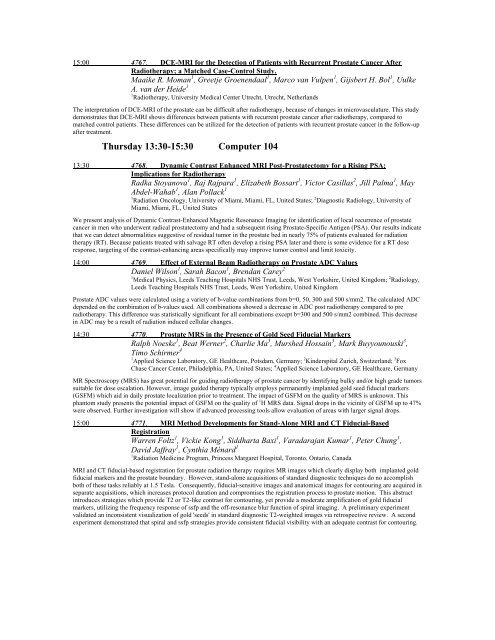ELECTRONIC POSTER - ismrm
ELECTRONIC POSTER - ismrm
ELECTRONIC POSTER - ismrm
Create successful ePaper yourself
Turn your PDF publications into a flip-book with our unique Google optimized e-Paper software.
15:00 4767. DCE-MRI for the Detection of Patients with Recurrent Prostate Cancer After<br />
Radiotherapy; a Matched Case-Control Study.<br />
Maaike R. Moman 1 , Greetje Groenendaal 1 , Marco van Vulpen 1 , Gijsbert H. Bol 1 , Uulke<br />
A. van der Heide 1<br />
1 Radiotherapy, University Medical Center Utrecht, Utrecht, Netherlands<br />
The interpretation of DCE-MRI of the prostate can be difficult after radiotherapy, because of changes in microvasculature. This study<br />
demonstrates that DCE-MRI shows differences between patients with recurrent prostate cancer after radiotherapy, compared to<br />
matched control patients. These differences can be utilized for the detection of patients with recurrent prostate cancer in the follow-up<br />
after treatment.<br />
Thursday 13:30-15:30 Computer 104<br />
13:30 4768. Dynamic Contrast Enhanced MRI Post-Prostatectomy for a Rising PSA:<br />
Implications for Radiotherapy<br />
Radka Stoyanova 1 , Raj Rajpara 1 , Elizabeth Bossart 1 , Victor Casillas 2 , Jill Palma 1 , May<br />
Abdel-Wahab 1 , Alan Pollack 1<br />
1 Radiation Oncology, University of Miami, Miami, FL, United States; 2 Diagnostic Radiology, University of<br />
Miami, Miami, FL, United States<br />
We present analysis of Dynamic Contrast-Enhanced Magnetic Resonance Imaging for identification of local recurrence of prostate<br />
cancer in men who underwent radical prostatectomy and had a subsequent rising Prostate-Specific Antigen (PSA). Our results indicate<br />
that we can detect abnormalities suggestive of residual tumor in the prostate bed in nearly 75% of patients evaluated for radiation<br />
therapy (RT). Because patients treated with salvage RT often develop a rising PSA later and there is some evidence for a RT dose<br />
response, targeting of the contrast-enhancing areas specifically may improve tumor control and limit toxicity.<br />
14:00 4769. Effect of External Beam Radiotherapy on Prostate ADC Values<br />
Daniel Wilson 1 , Sarah Bacon 1 , Brendan Carey 2<br />
1 Medical Physics, Leeds Teaching Hospitals NHS Trust, Leeds, West Yorkshire, United Kingdom; 2 Radiology,<br />
Leeds Teaching Hospitals NHS Trust, Leeds, West Yorkshire, United Kingdom<br />
Prostate ADC values were calculated using a variety of b-value combinations from b=0, 50, 300 and 500 s/mm2. The calculated ADC<br />
depended on the combination of b-values used. All combinations showed a decrease in ADC post radiotherapy compared to pre<br />
radiotherapy. This difference was statistically significant for all combinations except b=300 and 500 s/mm2 combined. This decrease<br />
in ADC may be a result of radiation induced cellular changes.<br />
14:30 4770. Prostate MRS in the Presence of Gold Seed Fiducial Markers<br />
Ralph Noeske 1 , Beat Werner 2 , Charlie Ma 3 , Murshed Hossain 3 , Mark Buyyounouski 3 ,<br />
Timo Schirmer 4<br />
1 Applied Science Laboratory, GE Healthcare, Potsdam, Germany; 2 Kinderspital Zurich, Switzerland; 3 Fox<br />
Chase Cancer Center, Philadelphia, PA, United States; 4 Applied Science Laboratory, GE Healthcare, Germany<br />
MR Spectroscopy (MRS) has great potential for guiding radiotherapy of prostate cancer by identifying bulky and/or high grade tumors<br />
suitable for dose escalation. However, image guided therapy typically employs permanently implanted gold seed fiducial markers<br />
(GSFM) which aid in daily prostate localization prior to treatment. The impact of GSFM on the quality of MRS is unknown. This<br />
phantom study presents the potential impact of GSFM on the quality of 1 H MRS data. Signal drops in the vicinity of GSFM up to 47%<br />
were observed. Further investigation will show if advanced processing tools allow evaluation of areas with larger signal drops.<br />
15:00 4771. MRI Method Developments for Stand-Alone MRI and CT Fiducial-Based<br />
Registration<br />
Warren Foltz 1 , Vickie Kong 1 , Siddharta Baxi 1 , Varadarajan Kumar 1 , Peter Chung 1 ,<br />
David Jaffray 1 , Cynthia Ménard 1<br />
1 Radiation Medicine Program, Princess Margaret Hospital, Toronto, Ontario, Canada<br />
MRI and CT fiducial-based registration for prostate radiation therapy requires MR images which clearly display both implanted gold<br />
fiducial markers and the prostate boundary. However, stand-alone acquisitions of standard diagnostic techniques do no accomplish<br />
both of these tasks reliably at 1.5 Tesla. Consequently, fiducial-sensitive images and anatomical images for contouring are acquired in<br />
separate acquisitions, which increases protocol duration and compromises the registration process to prostate motion. This abstract<br />
introduces strategies which provide T2 or T2-like contrast for contouring, yet provide a moderate amplification of gold fiducial<br />
markers, utilizing the frequency response of ssfp and the off-resonance blur function of spiral imaging. A preliminary experiment<br />
validated an inconsistent visualization of gold 'seeds' in standard diagnostic T2-weighted images via retrospective review. A second<br />
experiment demonstrated that spiral and ssfp strategies provide consistent fiducial visibility with an adequate contrast for contouring.
















